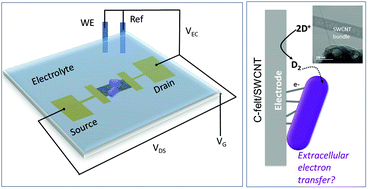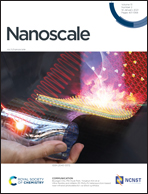Extracellular electron transfer across bio-nano interfaces for CO2 electroreduction†
Abstract
Acetogenic bacteria represent a class of organisms capable of converting reducing equivalents and carbon dioxide into products with carbon–carbon bonds. Materials-based bio-electrochemical approaches are attractive for supplying biological organisms directly with grid-supplied electrons to convert carbon dioxide to value-added chemicals. Carbon nanotube-modified biocathodes have emerged as promising candidates for microbial electrosynthesis with high yields of carbon product formation, but a fundamental understanding of extracellular charge transfer at this electrode-biofilm interface is still lacking. Here, we utilize solid-state interfaces between semiconducting single-walled carbon nanotubes (s-SWCNT) and a model acetogenic bacterium for mechanistic studies of electro-catalytic CO2 conversion to acetate. Studies of bacteria/s-SWCNT interactions in a transistor-based device suggest direct extracellular electron transfer (EET) at the bio-nano interface. Deuterium isotope labeling experiments confirmed that the availability of electrochemically produced H2 as a redox mediator does not limit the efficiency of EET and CO2 electro-reduction for C. ljungdahlii biofilms, suggesting the primary reducing equivalents are the electrons delivered across the electrode/bacterium interface or involvement of biological redox mediators. Additional isotope labeling studies demonstrate high Faradaic efficiency for CO2 electro-reduction at the SWCNT/bacterium interface. These results provide important information about EET across the bacterium/material interface in a model biocathode.



 Please wait while we load your content...
Please wait while we load your content...